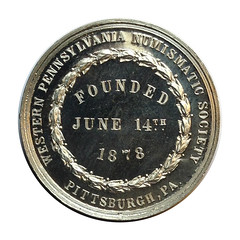
PREV ARTICLE
NEXT ARTICLE
FULL ISSUE
PREV FULL ISSUE
EARLY HISTORY OF THE WESTERN PA NUMISMATIC SOCIETY
Pittsburgh is my hometown and the Western Pennsylvania Numismatic Society was my first coin club. I'm a Life Member, and during my
time there I held every position from Curator to President. As Curator I had the opportunity to organize and read the club archives, and
to write a history of the Society's early years. Hardcopies have been deposited in the club archives and the libraries of the
American Numismatic Association and American Numismatic Society. For many years the history was also available on the WPNS web site. The
site is currently offline, but here are some excerpts. -Editor
Overview
The Society grew rapidly in its early years, and its members were very active. They quickly adopted a Constitution and set of Bylaws, and began forming a numismatic library and coin cabinet. To publicize the hobby of numismatics they set up a Society coin exhibit at the great Pittsburgh Exposition in 1878 and 1879. Souvenir medals were struck in each year to jointly commemorate the Exposition and the founding of WPNS. The Society did not develop in isolation; its members subscribed and contributed to various numismatic periodicals and auction sales from other cities. The Pittsburgh area was no numismatic backwater. There were at least four active coin dealers in Western Pennsylvania, and three of them were WPNS members. The first President of WPNS catalogued a total of 13 sales of numismatic material for auctions held in Pittsburgh. Society members were not without their differences. Disputes large and small arose among the members periodically. Separate incidents led to the expulsion of two of the founding members within a year. In 1882 the Society would expel another founder. Other founders were lost for the more usual reasons: sickness, death, or the lack of time or interest to continue numismatic activity. One founder sold his coin collection in 1879 and resigned from the Society in 1880. Another founder resigned in 1882, apparently to devote more time to his business affairs. The companies he founded made him one of the wealthiest men in the country, providing him the resources to resume his hobby in a big way at a later date. Like this prodigal founder, WPNS itself went through a period of dormancy. Its membership dwindled in the 1880's, and in 1889 the remaining members voted to dissolve the Society. But the fire of numismatics was not extinguished; its embers smoldered through this dark period and after two decades the Western Pennsylvania Numismatic Society was rekindled under its original constitution with several of its old members and founders back in the fold. The Society has continued to this day, its members meeting monthly to share their numismatic knowledge and fellowship. This paper summarizes the history of the first golden age of the Western Pennsylvania Numismatic Society, and is dedicated to the gentlemen who made up its membership through 1889. These men were the pioneers of numismatics in Western Pennsylvania. They blazed a trail still followed by the like-minded travelers of today. George W. Rode
As this paper will show, Rode's correspondence on behalf of the Society was extensive. He exchanged letters with the American Numismatic Society in New York, and publicized the Society's formation and activities via the editors of various contemporary numismatic periodicals. Without these precious records, little would be known today of the existence of the band of coin enthusiasts who created the Western Pennsylvania Numismatic Society. Rode became charter member number 12 of the American Numismatic Association, and was nominated by founder George Heath to serve on the organization's "Board of Temporary Organization." Rode also served as the A.N.A.'s Superintendent of Exchange in 1891-1892. At the October 1, 1892 A.N.A. Convention in Pittsburgh, he served as Secretary. The 1878 Exposition Medal
The Society resolved to sell the remaining 22 medals for the benefit of the Society at no less than 25 cents each. Also, "Mr. Maynard presented the Society with a silver exposition medal, for which the thanks of the Society were voted." At the September 20th meeting the Secretary had been "instructed to present one of the Society's medals to the various Numismatic Societies; and also to Messrs. Scott & Co. and Geo. H. Lovett, Esq." At the October 18th meeting letters of thanks were read from the Boston Numismatic Society, the American Numismatic and Archaeological Society, and the Numismatic and Antiquarian Society of Philadelphia. On October 25th the Secretary read a letter from Mr. Lovett offering "to strike Copper Exposition Medals for 20cts each, and in Silver for $1.00 each." The Society resolved to make 25 copper medals, 15 brass, and 7 silver. This would make a total of at least 8 silver medals, since Maynard had already donated one to the Society Cabinet. It makes sense that only eight were struck altogether (one for the Society, and one for each of the founders, except Rivett). The Society further resolved that the obverse die be cancelled after the above medals were struck. The medals were received by the Society by the November 15th meeting. On November 22nd a letter from Mr. Lovett was read, attesting to the number of medals struck. Secretary Rode reported that the obverse die had been cancelled.
For information on another longtime member of WPNS, see Dave Bowers' column in the December 2015 issue of The Numismatist
about A.C. Gies, adapted from his new book, Lost and Found: Coin Hoards and Treasures. "He began collecting in 1864 at age 9,
when he sought to obtain one of each of the various Civil War storecards issued by merchants near where he lived." -Editor
Wayne Homren, Editor The Numismatic Bibliomania Society is a non-profit organization promoting numismatic literature. See our web site at coinbooks.org. To submit items for publication in The E-Sylum, write to the Editor at this address: whomren@gmail.com To subscribe go to: https://my.binhost.com/lists/listinfo/esylum All Rights Reserved. NBS Home Page Contact the NBS webmaster 
|
